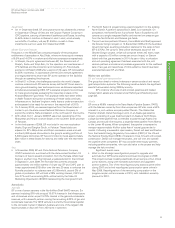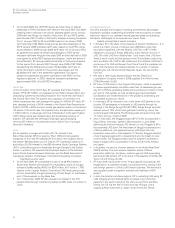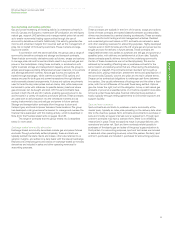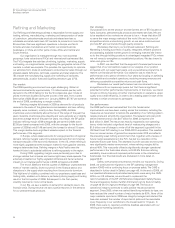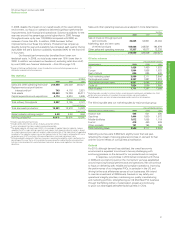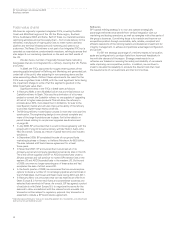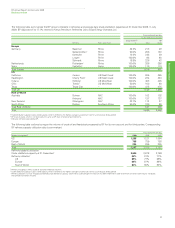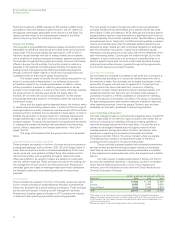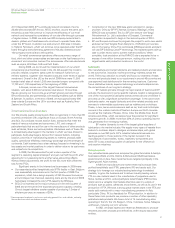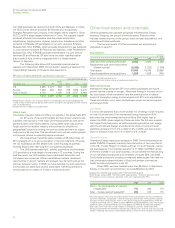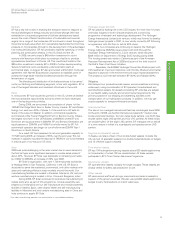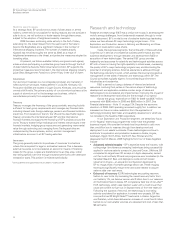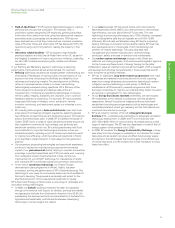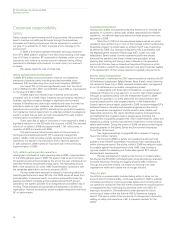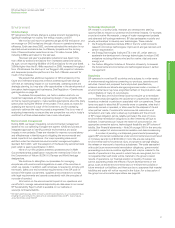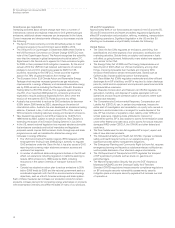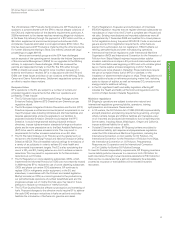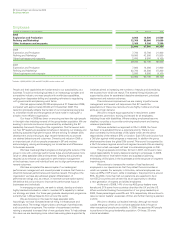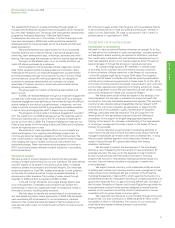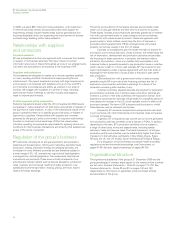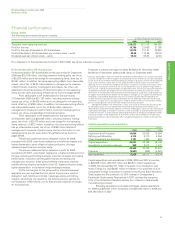BP 2009 Annual Report Download - page 45
Download and view the complete annual report
Please find page 45 of the 2009 BP annual report below. You can navigate through the pages in the report by either clicking on the pages listed below, or by using the keyword search tool below to find specific information within the annual report.
43
BP Annual Report and Accounts 2009
Business review
Business review
Business review
Biofuels
BP has a key role to play in enabling the transport sector to respond to
the dual challenges of energy security and climate change. We have
embarked on a focused programme of biofuels development based
around the most efficient transformation of sustainable and low-cost
sugars into a range of fuel molecules. BP continues to invest throughout
the entire biofuels value chain from sustainable feedstocks that minimize
pressure on food supplies through to the development of the advantaged
fuel molecule biobutanol. BP has production facilities operating, or in the
planning and construction phases, in the US, Brazil and the UK.
In 2009, we announced a $45-million investment in a joint
venture with Verenium which plans to construct a facility to produce
lignocellulosic bioethanol in Florida, US. This investment builds on the
$90-million investment made by BP in 2008 to further develop existing
Verenium technical work and develop a demonstration plant at
commercial scale. In August, BP also announced a $10-million multi-year
agreement with Martek Biosciences Corporation to establish proof of
concept for large-scale microbial biodiesel production through the
fermentation of sugars.
The blending and distribution of biofuels continues to be carried
out by our Refining and Marketing segment, in line with regulation. BP is
one of the largest blenders and marketers of biofuels in the world.
Wind
In wind power, BP has focused its portfolio in the US, where we believe
the most attractive opportunities exist and where we have developed
one of the leading wind portfolios.
During 2009, we announced the completion of phase I of the
100MW Flat Ridge Wind Farm in Barber County, Kansas. BP and Westar
Energy, Inc. each own 50% of phase 1 of the wind farm. BP sells its
share of the output to Westar. In addition, commercial operations
commenced at the Fowler Ridge Wind Farm in Benton County, Indiana,
the largest wind farm in the US Midwest at 600MW, where BP and
Dominion are equal partners in 300MW. BP and Sempra Generation are
equal partners in 200MW, and 100MW is wholly-owned by BP. Full
commercial operation also began at our wholly-owned 25MW Titan I
Wind Farm in South Dakota.
As a result, BP has increased its net wind generation capacity to
711MW during 2009, an increase of 65% over the prior year. This net
increase in capacity includes the disposal of 78MW of our wind interests
in India as part of our focus on US wind.
Solar
2009 was quite challenging in the solar market due to weak demand in
the first half year and a significant decrease in module sales prices of
about 40%. However, BP Solar was successful in increasing unit sales
by 41MW to 203MW, an increase of 25% over 2008.
BP Solar’s organization, with over 1,700 employees worldwide,
is headquartered in San Francisco, California, in the US. BP Solar is
structured to serve the residential, commercial, and utility markets with
sales and marketing offices in major markets around the world. Our
manufacturing facilities are located in Frederick, Maryland, US; and joint
venture manufacturing is located in Xi’an, China and Bangalore, Indiaa.
During 2009, BP Solar continued to restructure manufacturing to
reduce costs and, as part of this programme, module assembly was
phased out in Maryland and our cell manufacture and module assembly
facilities in Madrid, Spain, were closed. Wafer and cell manufacturing
facilities in Maryland and joint venture manufacturing sites in China and
India continue to supply BP Solar.
aOur Indian manufacturing operations are accounted for as a consolidated subsidiary.
Hydrogen power and CCS
BP has played a leading role in the CCS industry for more than 10 years,
and today focuses on both full-scale projects and a continuing
programme of research and technology development. The Hydrogen
Energy International Limited joint venture, which was formed to develop
hydrogen power projects in 2007, is now wholly owned by BP following
an agreement with Rio Tinto to sell its 50% share.
The two companies are continuing to develop the Hydrogen
Energy California 250MW power project with CCS through the
Hydrogen Energy International LLC joint venture, which secured
$308 million of Department of Energy (DoE) funding during 2009.
The funding award was made to California as part of the American
Recovery Reinvestment Act of 2009 and is part of the third round of
the DoE’s Clean Coal Power Initiative.
Separately, the 400MW Hydrogen Power Abu Dhabi project with
CCS reached an important milestone, with the Abu Dhabi environmental
regulator’s approval of the environment and social impact assessment.
The project is a joint venture between BP (40%) and Masdar (60%).
Shipping
We transport our products across oceans, around coastlines and along
waterways, using a combination of BP-operated, time-chartered and
spot-chartered vessels. All vessels conducting BP activities are subject
to our health, safety, security and environmental requirements. The
primary purpose of our shipping and chartering activities is the
transportation of our hydrocarbon products. In addition, we may use
surplus capacity to transport third-party products.
International fleet
The size of our managed international fleet has not changed since 2008.
At the end of 2009, we had 54 international vessels (37 medium-size
crude and product carriers, four very large crude carriers, one North Sea
shuttle tanker, eight LNG carriers and four LPG carriers). All these ships
are double-hulled. Of the eight LNG carriers, BP manages one on behalf
of a joint venture in which it is a participant and operates seven LNG
carriers.
Regional and specialist vessels
In Alaska, we retain a fleet of four double-hulled vessels. Outside the
US, we had 14 specialist vessels (two double-hulled lubricants oil barges
and 12 offshore support vessels).
Time-charter vessels
BP has 104 hydrocarbon-carrying vessels above 600 deadweight tonnes
on time-charter, of which 102 are double-hulled. All these vessels
participate in BP’s Time Charter Assurance Programme.
Spot-charter vessels
BP spot-charters vessels, typically for single voyages. These vessels are
always vetted for safety assurance prior to use.
Other vessels
BP uses various craft such as tugs, crew boats and seismic vessels in
support of the group’s business. We also use sub-600 deadweight tonne
barges to carry hydrocarbons on inland waterways.


